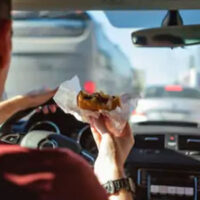What are the Three Kinds of Distracted Drivers?

As outlined below, the three kinds of distracted drivers are visually, manually, and cognitively distracted drivers. Frequently, at least two of these categories overlap. Hand-held cell phones, which are illegal for drivers to use in California and most other states, combine all three kinds of distracted drivers.
If one or more forms of driver distraction substantially cause injury, a Carlsbad personal injury lawyer can obtain substantial compensation for victims in court. This compensation usually includes money for economic losses, such as medical bills, and noneconomic losses, such as pain and suffering.
Visual Distraction
A tortfeasor (negligent driver) who uses a hands-free cell phone behind the wheel is the best example of a visually distracted driver. These motorists look at screens instead of the road.
Visual distraction is often unintentional. Most cell phones flash banner notifications on their home screens. Many drivers use GPS navigation devices, which feature a constantly-shifting map as well as text driving directions. These things pull drivers’ eyes off the road.
Marketing campaigns imply that hands-free is synonymous with risk-free. But that’s clearly not the case. In fact, according to several studies, driving while using a hands-free device is just as dangerous as driving while intoxicated.
A Carlsbad personal injury lawyer often pulls device use logs to establish device-related visual distraction. These logs usually reveal the extent of use and therefore the extent of visual distraction.
A lawyer must act quickly to preserve device use logs and other physical evidence. Otherwise, the tortfeasor might “accidentally” delete critical log information. These log entries are usually still stored on the device, but in these cases, retrieving that information is very time consuming. A straight line is the shortest distance between two points, and instant access to a device use log often speeds the settlement process.
Manual Distraction
Drivers are manually distracted if they take at least one hand off the wheel. This kind of distraction is especially dangerous when traffic, weather, and/or other conditions are less than ideal.
Drinking or eating while driving are examples of manual distraction. A tortfeasor with one hand on a cup of coffee obviously only has one hand on the wheel. Most motor vehicles are so big and fast that they require two hands to safely operate.
We mentioned the importance of preserving physical evidence above. This physical evidence could include items like half-empty cups and partially consumed sandwiches.
By themselves, such items do not prove the driver was eating or drinking and driving. But this evidence makes this fact more likely than not. A preponderance of the evidence (more likely than not) is the burden of proof in a civil claim.
Cognitive Distraction
Taking one’s mind off the road (cognitive distraction) could be a standalone form of driver distraction. Circumstantial evidence on this point includes the presence of a passenger in the vehicle and erratic driving before the wreck. These drivers are often talking to passengers or daydreaming instead of concentrating on driving.
More often than not, cognitive distraction transforms the first two kinds of distraction from everyday diving mistakes into actionable negligence, or a lack of care. People who watch screens usually think about what’s on those screens, and people who drink and drive aren’t laser-focused on driving.
Reach Out to a Thorough San Diego County Lawyer
Injury victims are entitled to substantial compensation. For a confidential consultation with an experienced personal injury lawyer in Carlsbad, contact the Pursley Law Firm. We routinely handle matters throughout SoCal.
Source:
cdc.gov/distracted-driving/about/index.html

